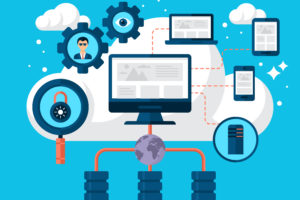As your company goes through its daily operations, it will eventually encounter a disaster that will cause downtime (floods, a power outage, or even human error). With the help of a reputable Managed IT Service Provider (MSP) and a Business Continuity Plan (BCP), you can minimize the impact and financial losses of any disaster to ensure your firm bounces back on its feet quickly.
What is a BCP?
This refers to a strategy that is formed out of recognizing the risks and threats facing an organization, finding out how they will impact operations, and executing strategies and procedures to protect company assets and personnel so that a business can continue operating even in the event of a disaster.
What common strategies do MSPs offer clients?
Backup-only
Of all the available BCPs to keep your organization running, this is the simplest to implement. The authorized technician will back up your important information and store a copy of it in three separate locations: in a data center, a USB drive and onsite. This will make sure that you have access to your files even if one of the copies are destroyed.
The backup-only plan is quite basic, as it only safeguards computer files instead of your network’s infrastructure. Without proper protection of your applications, workstations and servers, your business isn’t exactly disaster-proof
Cold site BCP
This strategy involves leasing a space for a temporary office in case disaster strikes. The building would have the basic equipment needed for data and servers to quickly get online, including network connectivity, cooling systems and power.
A cold site BCP is a perfect place to work in if the main facility has been damaged by events like floods or fires. This plan is inexpensive since the temporary building is only active when needed, saving your company money in expenses like cooling, power and maintenance.
However, this strategy is not popular with organizations that need to be back in business immediately since the service provider has to install the hardware, software and backed up data. The process normally takes a few days to complete, so your firm will stay inactive until everything is set up.
Hot Site BCP
This plan prioritizes uptime by having an MSP set up a remote office that mirrors your primary location. Businesses leveraging Managed IT Services can ensure seamless disaster recovery and IT continuity with expert support.“Some service providers even offer additional devices, such as tablets and phones, for businesses that opt for premium plans.
Unlike cold sites, hot sites remain active and continuously updated with the latest copies of your business data. This ensures that if your primary office experiences downtime, your employees can seamlessly transition to the backup location and resume operations without disruption.
However, while this setup significantly minimizes downtime, it comes with higher operational costs. Running two fully functional offices means increased expenses on power, cooling, internet, hardware maintenance, software licenses, and IT management.
What strategy is ideal for your business?
Before selecting a BCP, carefully study your requirements, data and system. For example, big corporations with steep availability requirements and a large IT budget may benefit from a hot site plan, while SMBs (Small to Medium Businesses) can start with a backup-only system to keep their sensitive data safe. No matter your strategy, make sure to test your BCP regularly and update any process necessary.
Disasters strike with little to no warning, and when it does, a business continuity plan can be detrimental to your business’ survival. Get in touch with Vodigy Networks today and we’ll give you a comprehensive risk assessment to determine the best plan for your business.




